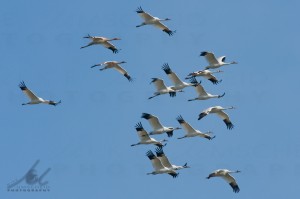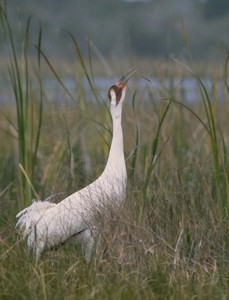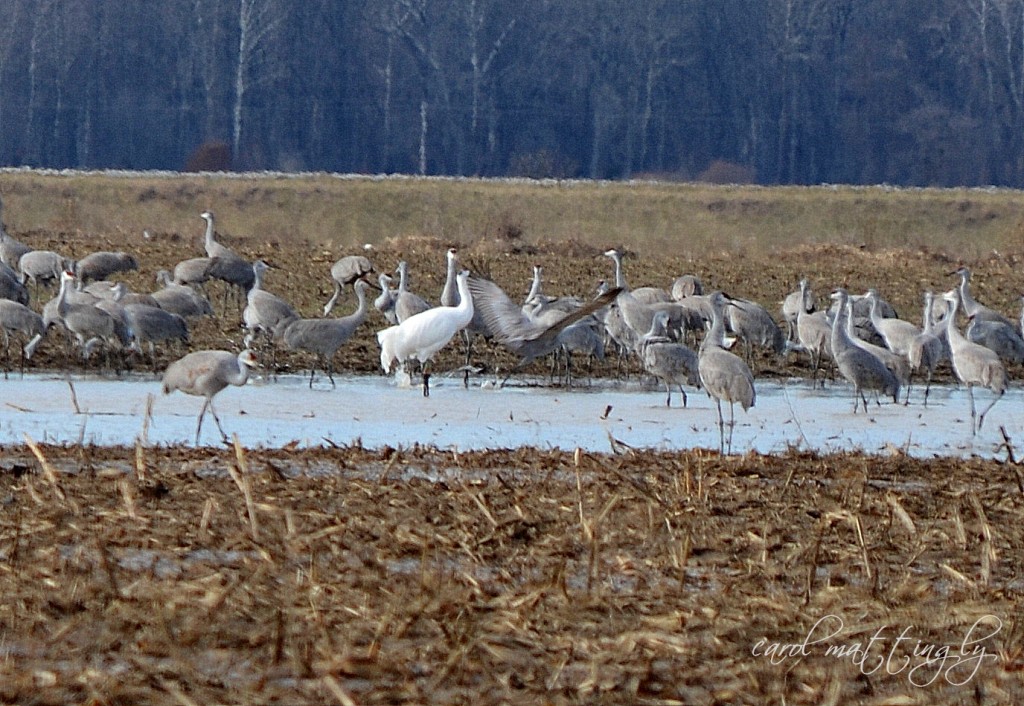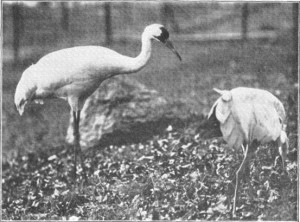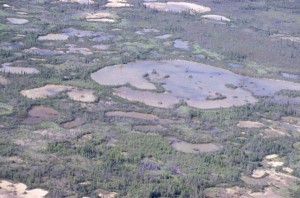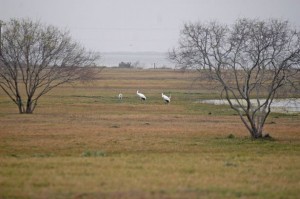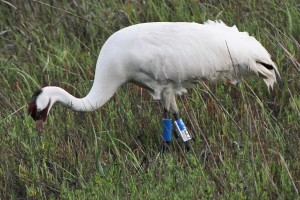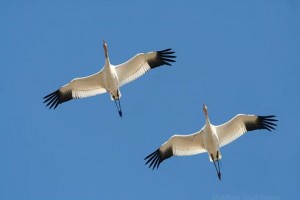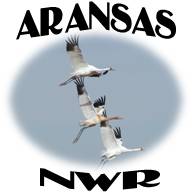Archive for the ‘Migrating Reports’ Category
MY SOAPBOX
April 1, 2013Editor Note: This exceptional article by Joe Duff is posted with permission of Operation Migration. Joe has a way with words as well as flying ultralight planes to lead young whooping cranes on their first migrations. The article is a lesson that should be read by all who venture onto wild lands and encounter wildlife. Please read and pass it on. Thanks Joe and O.M.
by Joe Duff, Operation Migration, Mar. 27, 2013
Earlier this month Fox 13 News in Tampa Bay posted an article about two photographers who overstepped the line of ethical wildlife observation by handling a two week-old Sandhill crane chick. They were captured on film and now wildlife officials say they could face charges if they can be found.
People do a lot worse to animals than handling their offspring, and although it is not condoned, that’s not the interesting part of this story. What is more telling is the mixed reactions posted in the comments section. Some people feel the perpetrators should be shot for their transgressions while others think they had every right to play with a baby bird.
The most common reaction is that maybe they didn’t know they were not allowed to handle wildlife. That excuse was also suggested when Whooping cranes were shot by kids showing off to their girlfriends. Many people commented that if the shooters had known what they were, or if more education was available, those birds wouldn’t have been shot — with a high powered rifle — on private property — at night. If that was a valid defence you could simply say, “Sorry I burned your house down. I didn’t know I wasn’t allowed to”. Ignorance of the law is not a defence, it is simply ignorance – not only of the rules but also of our responsibility to nature.
The fact that we even need laws at all is evidence of how we view our relationship with the environment. If we truly appreciated the connection between nature and ourselves, rules to protect it would be as unnecessary as a law against destroying our own wealth.
The planet, in all its complexity is the producer of everything we have, the materials we use to build our society, the water we drink, even the air we breathe. There is no other source for those essentials yet we use them as if they were inexhaustible. We are the prodigal heirs of a rich family. We did nothing to create the prosperity and we lack the ability, or the motivation, to maintain our inheritance, yet we spend the wealth with no concern for the future. But the environment was not inherited from our grandparents, More accurately it is borrowed from our grandchildren.
So what does it matter that a photographer in Florida handled a Sandhill chick to get a better picture when cranes are hunted in some states? It matters because it demonstrates how little we care about the creatures around us. Through his willingness to ignore the rules, he chose his own gratification over the welfare of the chick. Whether it was a desire for a better photograph or simple curiosity, he threatened the life of that bird for his own benefit. His ignorance of the consequences is as inexcusable as his ignorance of the law.
For those who think no harm was done, you don’t understand the stress load on the parent. A crane may abandon their chicks if the threat is too great. Instinct tells them it is better to escape and reproduce again next season than to be injured defending a chick that will perish as a result. If the chick is lost, the adult will survive, but if the adult is injured, they will both die.
As for the chick, they are vulnerable at that age. They hatch neither tame nor wild but have a natural fear of the unfamiliar. Most of their wildness is learned from the parent. An adult bird will remain wary despite several encounters with people, but a chick can become complacent after only one. Despite our good intentions, tame birds have a far shorter life span that their wild counterparts.
The point is, that all creatures are part of the ecosystems that make the world work. Damaging them even slightly, can have long term consequences that at some point will affect our lives. If we want to protect our future, we must learn to respect nature, even the baby Sandhills.
Bob Hunter, one of the founders of Green Peace, once said, “Conservationists are a pain in the ass, but they make great ancestors.”
http://operationmigration.org/InTheField/2013/03/27/my-soapbox/
Transmitters allow Crane Trust scientists to follow whooping cranes during migration
March 21, 2013Posted with permission of KearneyHub.com
By LORI POTTER Hub Staff Writer , Posted: Friday, March 8, 2013 2:00 pm
Whooping Crane Tracking Partnership
Whooping crane
A juvenile whooping crane wears a transmitter with a global positioning system that identifies its location four times daily for researchers at the Crane Trust near Alda and along the Central Flyway from Texas to Canada. There now are transmitters on 35-40 of the 279 migrating whooping cranes. Rick Rasmussen, Platte River Photography Crane Trust officials are asking the public to assist with Whooper Watch during the spring migration season. Adult whooping cranes are white with black wingtips. Visit the website at www.nebraskanature.org for details.
ALDA — Whooping cranes wearing solar-powered transmitters tell researchers at the Crane Trust near Alda and throughout the Great Plains states and Canadian provinces where the birds stop during spring and fall migrations.
But it’s still up to scientists on the ground to fill in the details.
“Where we’re taking a leading role is evaluating the stopover locations on the Central Flyway,” said Crane Trust Director of Science Mary Harner.
“It’s a big thing in science now,” Crane Trust Wildlife Biologist Greg Wright said about tracking wildlife with global positioning systems, “but it only goes so far … So you have to be there.”
Wright and other biologists go to the GPS-identified stopovers to make detailed surveys of the land cover and other habitat features, and to talk to landowners. “Teams are scattered (throughout the flyway), so someone always is relatively close and you can get there in good time,” he said.
The Whooping Crane Tracking Partnership began in 2008 as a research project conceived byCrane Trust staff, with support from U.S. GeologicalSurvey, to use a transmitting system to identify migration pathways.
Data gathering started in 2009 when the first whooping cranes were captured at wintering areas at Aransas National Wildlife Refuge in south Texas and breeding sites at Wood Buffalo National Park in Canada. The captures were authorized by the U.S. Fish and Wildlife Service and Canadian Wildlife Service.
Each captured bird is given a health check. Platform transmitting terminals with GPS systems and antennas are attached to their legs.
Harner said Neoprene is used on the inside of the devices as a cushion between them and cranes’ legs.
There are solar panels on the three exposed surfaces of the two-piece leg bands to maximize recharge of batteries that are expected to have a lifespan of three to five years.
Wright said there now are 35 to 40 whooping cranes with transmitters. “This technology was thoroughly researched on sandhill cranes before it was used on whooping cranes,” he added.
Harner said the project has collected a little over half of the location data that is expected over the duration of the research. The Crane Trust website says researchers expect to follow the birds in the field through 2015.
A February 2013 USGS report for the five core project partners — the others are the Crane Trust, Canadian Wildlife Service, Platte River Recovery Implementation Program and USFWS — summarizes the project’s history and data from 2012.
Location data was gathered for 36 whooping cranes during the 2012 summer breeding season in
Canada. During last fall’s migration, 261 stopover locations were documented, including one east of Lexington, one east of Kearney and one east of Wood River.
The report says 11 adults and one juvenile whooping crane were captured at Aransas this winter and the plan is to capture 10 more adults during winter 2013-2014. It also says that during the project’s lifetime, the goal is to have transmitters on about 30 juvenile (hatch-year) birds and 30 adults.
The project goals listed by the five core partners in a 2011 research partnership document are to advance knowledge of whooping crane breeding, wintering and migratory ecology; disseminate research findings for conservation, management and whooping crane recovery; and minimize negative effects of research activity on the cranes.
Other organizations supporting the project are the Gulf Coast Bird Observatory, International Crane Foundation and Parks Canada.
“Partners agree that this opportunity to mark wild whooping cranes with GPS technology represents the best prospect in the past 30 years to enhance understanding of whooping cranes and assess risks they face during their entire life cycle,” the USGS report says.
Wright said the cooperation of landowners where whooping cranes have been spotted has been a wonderful asset to the research.
“We’re certainly learning things,” he said, but the data collected so far is a small sampling of what researchers will have in the next year or two. “There’s really not a precedent for this.”
Harner said transmitters are activated immediately after they are placed on the cranes and are programmed to record four GPS locations daily, once every six hours.
There is a time lapse because transmitters upload new data approximately every 2½ days. Researchers are dispatched to survey the places where it’s known that whooping cranes have been.
Wright said that once the signals are downloaded, a decoding program must be used “so it means something to us.”
“Project partners monitor the whooping crane location data closely as the project continues,” Harner said, “and we will be working together over the next several years to continue collecting, processing and analyzing the data, and sharing research findings.
“Far-reaching partnerships make this landmark study successful, and we look forward to ongoing collaborations to advance our understanding of this magnificent species.”
email to: lori.potter@kearneyhub.com ________________________________________
WHOOPING CRANE FACTS, Whooping Crane (Grus americana)
Features: Tallest bird in North America, at 5 feet. Mostly white with black wingtips and face, and red head.
Numbers: Approximately 280 in a migratory flock that breeds in Wood Buffalo National Park in Canada and winters at Aransas National Wildlife Refuge in south Texas. In captivity or part of re-introduction efforts, 290.
History: There are accounts of whooping cranes seen during spring and fall migrations since European settlers arrived in Nebraska in the 1840s.
Lowest numbers: Due to hunting and habitat loss, only 15 birds remained in 1941.
Recovery challenges: Loss of habitat, altered wetlands, climate change and collisions with power lines.
Breeding: Whooping cranes normally lay two eggs, with one egg-chick surviving. Adult pairs have been seen with twins, including five sets arriving at Aransas in 2010.
Behaviors: Territorial at breeding and wintering grounds, and use the same areas year after year.
Migration route: About 2,500 miles long and 300 miles wide through Texas, Oklahoma, Kansas, Nebraska, South Dakota, North Dakota, Saskatchewan and Alberta.
Critical habitat: Four sites designated in the 2005 International Recovery Plan for the Whooping Crane are Salt Plains NWR in Oklahoma, Cheyenne Bottoms State Waterfowl Management Area and Quivira NWR in Kansas, and the Platte River between Lexington and Denman. ________________________________________
Whooper watchers still sought
ALDA — Crane Trust officials are seeking public help to spot endangered whooping cranes during their spring migration through Nebraska in March and April.
If you see a whopping crane, call Whooper Watch at 888-399-2824 to report the time, exact location, crane numbers and activities.
A scientist will be sent to confirm the sighting and document location features.
Do not disturb the birds. Stay in a vehicle or established viewing area at least 2,000 feet (0.4 of a mile) away. Don’t tell others of the sighting or location to avoid attracting more attention.
There are only about 280 whooping cranes in the wild flock that winters in south Texas and goes to summer breeding grounds in Canada’s Prairie Provinces. During their 2,500-mile spring and fall migrations, they may stop for one to several days along the Platte or other Nebraska rivers and wetlands to rest and feed.
Visit the website at www.nebraskanature.org to download a flyer that includes bird identification information and Whooper Watch rules and procedures.
Winging it 2,500 Miles to Rear Their Families
March 9, 2013by Chester McConnell, Whooping Crane Conservation Association
Some whooping cranes are heading north. They are departing from Aransas Refuge on the Texas coast. They’re on their way to Canada’s Wood Buffalo nesting grounds 2,500 miles away. Only a small number from the Aransas/Wood Buffalo flock have departed from Aransas but others will soon follow. According to Dr. Wade Harrell, U.S. Whooping Crane Recovery Coordinator: “It appears that some whooping cranes have started to migrate back north, which is several weeks earlier than normal. Perhaps this is not surprising given the unusually warm and dry winter that the southern plains have experienced.”
March brings restlessness to the wintering cranes as days get longer. Cranes of the Aransas/Wood Buffalo flock could encounter dangerous cold and stormy weather if they move north too rapidly. But, whoopers heading to Canada must race for their nesting grounds where summers are short. Adult pairs have to build a nest, lay two eggs and incubate the eggs for 30 days when the chicks hatch. Then they must feed the chicks large amounts of food to get the youngsters ready for the long migration back to Texas. So, whoopers have much to do in a short time on the nesting grounds. Hopefully the northern habitats will be thawed and ready for nesting when they arrive. Most of the Wood Buffalo nesting area is still currently frozen. But whooping cranes are wise and the migration to Canada normally requires 40 to 60 days.
So most likely icy conditions will change before most of the cranes arrive there.Yet, whoopers are definitely in their migration mode. Citizen whooper watchers have reported birds in northern Texas, Oklahoma, Kansas and Nebraska. Eight whoopers were reported as far north as North Platte, Nebraska. Migration records kept by the Whooping Crane Conservation Association indicate about two dozen birds along the migration route. Some of these observations have been verified by U.S. Fish and Wildlife Service refuge managers.
Hopefully all the whooping cranes currently on the way to Canada and those waiting on Aransas Refuge, Texas will have a safe 2,500 mile migration. We know that, sadly, two members of this flock will not be with them. They were shot and killed during the past year, one by a poacher (South Dakota) and the other by a hunter (Texas). Both of the men who killed the whoopers have been prosecuted and received large fines and other punishment. The Whooping Crane Conservation Association urges state and federal wildlife agencies and birding organizations along the migration route to increase their efforts to educate hunters and other citizens about the compelling need to help protect endangered whooping cranes.
Interestingly, Dr. Harrell’s “Wintering Whooping Crane Update” report (3/7/2013) described the movements of one whooper family that has GPS transmitters attached to them: “Update February 24: The marked family group (two adults and one juvenile) from Granger Lake left arriving in North Texas that evening. They stayed through Feb. 28 and then moved to SW Oklahoma where they remained through March 2. They then moved on to Quivira National Wildlife Refuge in South Central KS, a traditional migration stopover site for whooping cranes, where they currently remain.”
More about whooping crane migration can be learned by reading The Whooping Crane Tracking Partnership’s recently issued biannual report. The following is a summary of the data captured from the 2012 breeding season through fall migration (approximately May through November). Background information about the Partnership can be found on the following link: https://whoopingcrane.com/tracking-whooping-cranes-telemetry-update/
Excerpts from the report: “During the 2012-2013 season, information was gathered about location from 36 transmitters during the breeding season and data from 30 transmitters during fall migration. Prior to migration, six transmitters stopped providing data. With the help of the technology, the mortalities of two juveniles and two subadults were confirmed on the breeding grounds of Wood Buffalo National Park. The two other transmitters were confirmed to have broken antenna. The tracking technology also revealed that three cranes spent the summer months in south-central Saskatechewan and 29 marked birds completed the fall migration.”
“The birds began their fall migration from Canada on September 7, 2012, and data indicates that all of the birds arrived on the Texas coast by November 27, 2012. It took the cranes an average of 46 days to make the migration with the migration time ranging from 21 to 67 days. The data shows whooping cranes used 261 different locations where they stopped and stayed for more than one night. Stopover locations occurred in every state and province in the Great Plains. Cranes spent the most time at staging sites in Saskatchewan and the Dakotas. The general migration corridor used was similar to past migrations and there were no mortalities detected during the migration.”
“The GPS tracking devices attached to the whooping cranes are programmed to record four locations daily and provide both daytime and nighttime locations. Transmitters upload data approximately every 2.5 days allowing for monitoring survival. The technology allows biologists to learn which habitats are being used and where the birds stop during their migration – important information when prioritizing management decisions.”
The Whooping Crane Conservation Association supports the Whooping Crane Tracking Partnership’s in hopes that the information they collect will help in the improved management of the whoopers.
First Incidental Take Permit for Whooping Cranes at an Individual Wind Farm
February 7, 2013by Chester McConnell, Whooping Crane Conservation Association
The U.S. Fish and Wildlife Service (FWS) is considering issuing the first-ever Incidental Take Permit to a wind farm for endangered Whooping Cranes and threatened Piping Plovers. If FWS grants the permit, the Merricourt Wind Power Project in North Dakota would be protected from prosecution under the Endangered Species Act (ESA) for killing Whooping Cranes and Piping Plovers.
Whooping Crane Conservation Association contends that: 1) FWS failed to give the public adequate notice on an important endangered species issue, 2) the agency is only preparing an Environmental Assessment for a precedent-setting take permit of significant environmental impact, and 3) there are fewer than 300 individual Whooping Cranes left in the wild Aransas/Wood Buffalo flock which migrates through North Dakota.
The Merricourt Wind Project proposes to build 100 turbines within a 22,400 acre project area and build 33 miles of access roads. FWS has advised the project developer that the wetland stopover habitat in the project area is critical to the survival and recovery of the Whooping Crane. The site is also about two miles from designated critical habitat for Piping Plovers. In addition, FWS has told the developer that three ESA candidate species may be present at the site (Sprague’s Pipit, Dakota skipper, and Powesheik skipperling).
Whooping Crane Conservation Association president Brian Johns recently wrote a letter to the project manager explaining the Association’s position. President Johns wrote: “The Whooping Crane Conservation Association (WCCA) would like to express our concerns over the placement of the proposed Merricourt Wind Power Project in North Dakota. Wind Power projects have been identified in the International Recovery Plan for the Whooping Crane as a potential threat to flying Whooping Cranes. As you know the Whooping Crane is listed as Critically Endangered by the IUCN as well as both the United States Fish and Wildlife Service and the Canadian Wildlife Service. The Aransas/Wood Buffalo population (AWBP) which contains fewer than 300 individuals is the only self-sustaining wild population of whooping cranes. With such a limited population, the genetic contribution of each individual is critical to the survival of the species.”

The Merricourt Wind Project proposes to build 100 turbines within a 22,400 acre project area and build 33 miles of access roads.
John’s letter continues: “The proposed placement of this wind power project directly within the migration corridor of the AWBP seems like an accident waiting to happen. We understand that the USFWS may grant an Incidental Take Permit, which would allow the project to proceed. The WCCA is opposed to locating any wind power projects within the migration corridor. If such a project were to proceed, we would expect the USFWS to ensure that all mitigation measures listed in the Whooping Crane Wind Development Issue Paper are taken to avoid harm to the AWBP of Whooping Cranes.”
Operation Migration On Estimating Whooper Numbers
February 2, 2013Operation Migration’s “In The Field” web page explains, “Debate continues in the Whooping crane world about the methods US Fish and Wildlife Service is now using to count Whooping cranes at the Aransas National Wildlife Refuge.”
“For almost 30 years, retired Whooping Crane Coordinator, Tom Stehn made a direct count of each bird while flying transacts over the refuge. The accuracy of that method was questioned because birds may move between the aircraft passes and been counted more than once.”
“The new system employed since Stehn’s retirement is called ‘distance sampling’. It consists of making multiple parallel survey flights over a large area and applying a formula to the number of cranes spotted to come up with a population estimate.”…
“The concern is that distance sampling is generally used to estimate the size of large populations and there are fewer than 300 Whooping cranes at Aransas. Many feel that a direct count could provide a more accurate number.”
To read the complete article, click on: http://operationmigration.org/InTheField/2013/02/01/controversy-heats-up/
Photographing a Whooping Crane
January 22, 2013Editor’s note: Our members and viewers of our web site often write us about their observations of whooping cranes. Some even send us photos. We always appreciate these. We enjoy sharing some of these submissions with you. We just received some photographs from Carol Mattingly. She also wrote about her experience. Her article is posted below. If you have interesting experiences and photos and would like to have us place them on the web site, please go to our web site whoopingcrane.com . Then click on “Report A Sighting” and fill out the form and click “Send”.
Photographing a Whooping Crane
By Carol Mattingly, Carol Mattingly Photography
Turning left onto a two lane dirt farm road, I edged my car just past an unplowed field and there standing in several inches of water picking at the ground in hopes of finding food was a beautiful adult Whooping Crane. How he could possibly find anything to eat in this field made me wonder. This region had just experienced the most severe drought in recorded history just this past summer. The seeds planted in these fields could not possibly have yielded any crops. Possibly weed seeds and insects were there.
It was a sunny Sunday afternoon and I had made my way to south Indiana just on the other side of a river bridge. The Bottoms is generally what the locals call this area. And after heavy rains the week before, I could see why it is called bottomland. There were large pools of standing water in all of the fields.
And for as far as the eye could see, on this particular Sunday, there were hundreds and hundreds and hundreds of Sandhill Cranes. And standing amongst the Sandhills was this one solitary Whooping Crane. I wondered if it had mated with one of the Sandhill Cranes and would it be traveling with this huge flock of Sandhill Cranes for years to come.
Seeing my first Whooping Crane was a fantastic treat, but getting a fairly decent image of the crane was ever better. I did not want to get too close for fear of frightening the birds. The Whooping Crane stood for some time looking around and I knew that was my opportunity to snap a few images. I love the way the Sandhill Cranes feathers lay across the back of their rump in a poof. But this Whooping Crane’s white feathers lying across his rump was so beautiful. I wonder if he knew he was the star of the show that Sunday. See my photo below:
Whooping Cranes from Despair to Hope to Progress
December 23, 2012*************History Briefs compiled by Whooping Crane Conservation Association************
The recorded history of whooping cranes has ranged from beliefs that the birds would become extinct to efforts to restore the flock. Whooping Crane Conservation Association member Pam Bates has researched the literature and come across some interesting material. Some of Pam’s findings are posted here for your interest:
Despair: The following is from the Gutenburg Project and dated 1913.
OUR VANISHING WILD LIFE ITS EXTERMINATION AND PRESERVATION BY WILLIAM T. HORNADAY, Sc.D. Page 19. “The Whooping Crane. —This splendid bird will almost certainly be the next North American species to be totally exterminated. It is the only new world rival of the numerous large and showy cranes of the old world; for the sandhill crane is not in the same class as the white, black and blue giants of Asia. We will part from our stately Grus americanus with profound sorrow, for on this continent we ne’er shall see his like again. The well-nigh total disappearance of this species has been brought close home to us by the fact that there are less than half a dozen individuals alive in captivity, while in a wild state the bird is so rare as to be quite unobtainable. For example, for nearly five years an English [Page 19] gentlemen has been offering $1,000 for a pair, and the most enterprising bird collector in America has been quite unable to fill the order. So far as our information extends, the last living specimen captured was taken six or seven years ago. The last wild birds seen and reported were observed by Ernest Thompson Seton, who saw five below Fort McMurray, Saskatchewan, October 16th, 1907, and by John F. Ferry, who saw
one at Big Quill Lake, Saskatchewan, in June, 1909. The range of this species once covered the eastern two-thirds of the continent of North America. It extended from the Atlantic coast to the Rocky Mountains, and from Great Bear Lake to Florida and Texas. Eastward of the Mississippi it has for twenty years been totally extinct, and the last specimens taken alive were found in Kansas and Nebraska. Photo was taken at “WHOOPING CRANES IN THE ZOOLOGICAL PARK ”
Hope: Two articles written by John O’Reilly in 1954 and 1955 issues of “Sports Illustrated” describe the extraordinary efforts of individuals, conservation organizations and government agencies to protect and manage the endangered whooping cranes. These two articles are posted below:
The surviving remnant of the great race of whooping cranes, hardly more than two dozen birds, will be “escorted” this fall from Canada to Texas. That is, they will be escorted insofar as it is possible for human beings to escort wild creatures which fly high and come to rest in lonely places. But, elusive though they may be, these huge white birds with the black wingtips will be followed on their route by thousands of well-wishers.
SPORTS ILLUSTRATED
Here Comes The Cranes, September 20, 1954
by John O”Reilly
The Survivors of America’s tallest birds will be “escorted” south
In advance of their coming a campaign is being conducted to alert the human population along the migration route of the cranes. As was the case last fall, radio stations will broadcast appeals to report the birds but not molest them. Their trip will be announced by newspapers. Sportsmen’s clubs and civic organizations have helped spread the word. Thousands of post cards bearing the facts and a picture of a whooper have been mailed to persons living along the flight lane.
All this is part of the international effort to help America’s tallest bird in its struggle for existence.
ONLY 26 ARE LEFT
When the birds migrated last spring there were 26 whooping cranes left—in the entire population of the species. Grus americana doesn’t occur in other parts of the world and they have been studied so thoroughly that the chance of even a single bird being discovered outside this group is highly improbable.
Two of the cranes, found crippled by gunshot, are now captives in a New Orleans zoo. The rest winter on the wide marshes and prairies of the 47,000-acre Arkansas Federal Wildlife Refuge on the Texas coast, 40 miles from Corpus Christi. There they live singly and in family groups, each family occupying a territory of some 500 acres from which other cranes are driven. Without the use of a blind it is difficult to get within half a mile of them. On a trip to the refuge I jeeped and stalked the prairies for days before I got a close view of the cranes. When a pair finally flew right over me I was told that I was luckier than most.
The exact location of the nesting grounds of the remaining whoopers has not been found. This summer a scientist hovering in a helicopter over the wild country south of Canada’s Great Slave Lake looked down and spotted four whooping cranes, three adults and a young one. His find was the best evidence so far of the general location of their breeding grounds.
The whooping crane once inhabited the central part of the continent from the Arctic Coast to central Mexico. It demanded plenty of space in which to live and rear its young, and when it stood at full height to utter its challenging buglelike call, it was almost six feet tall. But as the prairies were tamed and planted, the whooping cranes dwindled steadily.
PROJECT FOR SALVATION
Now the Fish and Wildlife Service, the Canadian Wildlife Service and the National Audubon Society are partners in a project designed to save the whooping crane from extinction. Numerous state agencies and private groups are cooperating. One of the prime workers on the project is Robert P. Allen, research ornithologist of the National Audubon Society. Allen devoted three years to an intensive study of the cranes, hoping to find a way to halt their decline.
During that time he lived with the birds on the lonely Texas marshes in winter. In early spring he took off by plane in advance of their migration and intercepted them along the Platte River in Nebraska. He traced their migration route through Texas, Oklahoma, Kansas, Nebraska, the Dakotas and into Saskatchewan where they disappeared into Canada’s north country. He flew thousands of miles in the far north in a vain search for their nesting grounds.
People often ask how on earth the cranes know enough to go right to the refuge to spend the winter. The answer is that the presence of the whooping cranes there is historic and was one of the main reasons why the refuge was established in 1937.
As a result of Allen’s recommendations, numerous steps have been taken to aid the cranes. One of the main objectives has been to find the nesting grounds and learn whether there are any factors there which are limiting the increase. Canada has announced that when the nesting area is found it will be declared an inviolate sanctuary. Plans are now being made for a systematic search of the area next summer.
Each fall the refuge men are waiting eagerly as the cranes come back in little groups. By early December they are all in and the refuge men make an exact count by flying over them in small planes. In recent years the flock has returned with an average of four young birds. But usually a few of the parents are lost, some from being shot, and others from unknown causes. Sometimes the population fluctuates perilously. The gain or loss of a single bird is vital to the survival of the race.
Last year there was a gain. Twenty-one whoopers took off for the North in the spring and in the fall all 21 returned, bringing three gawky offspring with them. This fall more eyes than ever will be on the alert in the country’s most unusual bird-watching program.
SPORTS ILLUSTRATED
Whoop for Cranes – November 21, 1955 by John O’Reilly
Scientists who searched arduously and long for the nests of the all-but-extinct whooping crane rejoiced last week: its young are on the increase. Among birds, the all-but-extinct whooping crane is most symbolic of the mighty sweep of wilderness that once was America. Tall, wary and aloof, the whooping crane demands plenty of living space. It proclaims its utter freedom with a far-reaching, buglelike call. It regards the intrusions of man with an imperious look in its cold, yellow eyes. Although but a remnant of a once-great race, Grus americana seems imbued with a special urge to survive.
These are some of the reasons why the news of the return of 20 adult whooping cranes with a bonanza of eight young has just been greeted with such national exuberance. Last spring 21 whoopers left their wintering area on the Texas coast for their breeding grounds in northern Canada. By last Monday all except one adult were back in Texas. This bird may be lost or it still may be on the way. Sometimes the last migrants don’t get back until the first week in December.
A CAUSE FOR REJOICING
The appearance of eight young birds this year is cause for rejoicing among followers of the cranes both in the United States and Canada. The eight youngsters represent the largest crop since wildlife experts first started counting the remaining cranes 17 years ago. The largest previous number was seven young in 1939.
Anxiety over the migrating whoopers mounted steadily during the past two months as they made their 2,400-mile trip. Julian Howard, manager of the 47,000-acre Aransas National Wildlife Refuge near Austwell, Texas, has been swamped with demands for information on the returning whooper families. Never has the welfare of a migrating band of birds been of such concern to so many.
During the summer, workers on Project Whooping Crane, the international effort to keep the big birds flying, discovered the long-sought nesting ground of the last of the whoopers. As a result, it was known that the cranes had hatched at least six young.
Last summer, just as interest in the whoopers was reaching its height, the United States Air Force announced plans for establishing a photoflash bombing range within a mile of part of the birds’ wintering grounds. The National Audubon Society and local Audubon societies all over the country sent protests. More protests came from the National Parks Association, the United States Fish and Wildlife Service, the National Wildlife Federation, the American Nature Association and individuals who had helped in the struggle to save the cranes. Then the Canadian government made a verbal inquiry to the State Department. Last month the Air Force announced that its proposal to establish the bombing range had been withdrawn.
Old records show that whooping cranes once nested on the great prairies of the West and ranged over most of the country. Gradually they gave way before the plow and the gun, disappearing as their nesting grounds were settled and turned into wheat lands.
As long ago as 1923 some wildlife writers had declared the whooping crane extinct. The “last” nest had been found in Saskatchewan in 1922, and the young bird was taken from it, stuffed and placed in a museum. The existence of the wintering group on the Texas coast was known only to a few and it was their presence that led to the establishment, at that spot, of the Aransas National Wildlife Refuge. The big fight to save the whoopers started when Project Whooping Crane was set up 10 years ago.
The closest human associate of the whoopers since then has been Robert P. Allen, a square-built, black-haired Pennsylvanian. As research ornithologist of the National Audubon Society and leader in Project Whooping Crane, he had studied the cranes on their wintering grounds but his attempts to find their nesting sites in the far north had been fruitless. But, as he and others continued their work, public interest increased steadily.
The cause of the whooping crane became of such widespread interest that thousands of persons were on the lookout for them. Then in June 1954 some whoopers were spotted from a plane in Canada’s Wood Buffalo National Park, a wilderness area of 17,300 square miles, most of which is never visited by anybody, tourists or otherwise.
This knowledge led the international partners in Project Whooping Crane—the Canadian Wildlife Service, the’ U.S. Fish and Wildlife Service and the National Audubon Society—to launch an all-out effort to find the nests. Their aim was to discover whether anything or anybody was molesting the birds as they reared their young.
Allen was ready to start north to lead the expedition when William A. Fuller, biologist of the Canadian Wildlife Service, became the first man to see a wild whooper’s nest since that “last” nest was reported 33 years ago. Fuller was flying in the wild country along the Sass River on May 18 with Edward Wellien and Wesley Newcomb of the U.S. Fish and Wildlife Service when he spotted a pair of whoopers and a nest. On the same flight two more nests were seen.
This news spurred the expedition to action. Next to the actual finding of the nests the most important thing was to reach the area on the ground; to learn what, if any, were the dangers to the cranes; to study their nesting habitat and collect samples of their food. Allen hurried north and was met at Fort Smith, an outpost on the Slave River, by Raymond Stewart of the Canadian Wildlife Service and Robert E. Stewart, biologist of the U.S. Fish and Wildlife Service.
Fort Smith is the jumping-off place for prospectors in the uranium rush. Men come and go and low conversations about uranium strikes are carried on in corners. So, as the three outfitted for their expedition, they were greeted with knowing smiles and sly smirks when they said they were heading into the bush to look for birds.
It was chilly on the morning of May 23 when the expedition set out down the mighty Slave River, which winds northwest to Great Slave Lake. At a great bend in the river, 44 miles from Fort Smith, they unloaded their supplies, cooked a meal and headed into the spruce forest. The Indian packers, two of them carrying the canoe, were strung out behind them. Nine hours later the three scientists said good by to the Indians and made their first camp on the shore of Long Slough.
As they moved down the slough the next morning in their overloaded canoe, the country around them was feeling the first touch of spring. Cattails were just beginning to show green. Canvasbacks, goldeneyes, buffleheads and other waterfowl were all about them. To the west they caught occasional glimpses of buffalo herds, with a spring crop of reddish-brown calves. They were still in high spirits when they made another portage, pitching their second camp on the banks of the Little Buffalo River. They moved up the Little Buffalo, still feeling fine. Turning into the Sass River, they rounded a bend to encounter their first trouble. It was a log jam, not of lumber logs but of trees and snags. They soon realized that the Sass was just one log jam after another, a fact that had not been apparent during their aerial survey.
They were sitting on the bank of the river, returning the stares of solemn buffalo and wondering what to do next, when they learned from their radio that they were believed lost and had become the objects of a search. The Northwest Mounted Police and park officials had been alerted. Unable to send out messages on their radio, they decided to strike for Fort Resolution on Great Slave Lake, where word of their safety could be sent out. After a turbulent trip down the Little Buffalo, they persuaded a Chipewyan Indian to carry a message across the frozen expanse of Great Slave Lake to Fort Resolution. Three days later Pat Carey, veteran bush pilot, dropped into the river mouth in his plane and took them back to Fort Smith. They were back where they had started.
A TRY BY HELICOPTER
Disappointment over their failure was forgotten on learning they could get the services of a helicopter which had been working north of Great Slave Lake. The helicopter transported them and their gear but, blown off course by a strong cross wind, the pilot became confused and dropped them 20 miles from where they thought they were landing. They didn’t realize this dismal fact until they had fought their way on foot for three days through swamps and sloughs.
Now they were really lost, and to make matters worse mosquitoes had emerged in millions, augmented by black flies, deer flies and a superdreadnaught called the bulldog fly. Their only relief from the clouds of insects came at night when they shut up their tent, killed the mosquitoes that were waiting inside and went to sleep.
At last, admitting they were licked, they put their canoe in the nearest river and started downstream. It turned out to be the Sass, the river of log jams. This time they cut their way through or portaged around 42 log jams, using the ax as much as the paddle. Reaching the Little Buffalo River, they went downstream and made the long portage back to the Slave River where a boat took them once more back to Fort Smith.
All told, they had been in the mosquito-infested woods for a month and hadn’t reached the home of the cranes. They had called the whole thing a failure and were ready to pull out when they learned another helicopter was available. Bob Stewart went back to Washington but Ray Stewart and Bob Allen prepared their gear for a third assault of the vast swamps.
This helicopter dropped them in the right spot and, as before, they started scouring the area on foot. Several days later Allen and Stewart emerged from a thicket to see a flash of white ahead of them. Slipping up, they came upon an adult whooping crane, drawn up to its full height of five and a half feet, silent and alert. Nearby was another. The two birds separated, finally moving out of sight. It was not until later that they learned this pair was hiding two offspring from them.
The goal had been reached. For 10 days the scientists studied the nesting habitat of the cranes. They collected specimens of frogs, fish, snails and other animal life which form the summer diet of the cranes. They also collected plant samples and made notes on everything that might have a bearing on the life of the whoopers.
Their work done, the helicopter ferried them out to the Slave River and they came up the river through the arctic twilight to Fort Smith in an outboard-driven skiff. Several days later I joined Bob Allen and Bill Fuller on a final aerial survey of the nesting area. As we moved over this watery world the scientists spotted two big, white birds. George Dannemann, our pilot, circled down to where we could tell they were whooping cranes. As the plane banked in a tight circle, we all saw not just the one, but two rusty-brown youngsters, two feet tall and standing between their white parents.
The scientists could restrain themselves no longer but began letting out whoops that would have done credit to the birds themselves. “Two young,” shouted Allen, and we all yelled in joy at just about the rarest sight that the bird world can offer in North America.
We saw two more fledglings on that flight and the scientists were jubilant. They and the thousands of others in the United States and Canada who are pulling for the whoopers know the cranes can never be brought back to their former numbers. But they also know that if Grus americana should disappear altogether it would mean the loss of something truly representative of the North American continent, for whooping cranes are nowhere else to be found.———End of O’Reilly article.
Voices from the Past: A 1954 recording of whooping cranes at Aransas. Pam Bates explains, “The Macaulay Library has 12 different whooping crane recordings but this one was my favorite because it talks about 1954 being the first year that they had 3 young whoopers that migrated with their parents from Canada. The whooping Crane population at Aransas was 24 that winter.”
Pam Bates advises, “The first speaker is Arthur Allen, a renowned ornithologist and who the Arthur A Allen Award is named after. Julian Howard, the second person to speak and mentions the annual count for 24 was the manager of Aransas at the time. Click on the link and follow:
ML: ML Audio 2739: Whooping Crane macaulaylibrary.org Finally, to hear the interesting Whooping Crane calls click on:
Unison (334kb wave)
Present: John O’Reilly was correct when he wrote in 1955 that “They and the thousands of others in the United States and Canada who are pulling for the whoopers know the cranes can never be brought back to their former numbers. But they also know that if Grus americana should disappear altogether it would mean the loss of something truly representative of the North American continent, for whooping cranes are nowhere else to be found. ”
Thank goodness that some of our government agencies and private conservation organizations continued to work to restore the whooping crane flock. The Whooping Crane Conservation Association has focused on this objective for over half a century. Very slowly during the past 57 years the flock has increased to approximately 300 in 2012. That’s progress by any measure.
USFWS Whooping Crane Meeting Video
November 7, 2012by Ron Outen, Regional Director, The Aransas Project
On the evening of October 24, TAP attended a second public presentation by USFWS on the new distance sampling methodology being used at Aransas National Wildlife Refuge. Refuge Biologist Brad Strobel again presented his Powerpoint presentation for a small audience. TAP captured the presentation on video presentation on video, and has also posted the PowerPoint presentation to the TAP website Note that this PowerPoint is from the Oct. 4, 2012 presentation, but the content is essentially the same one used at the Oct. 24, 2012 presentation (minor changes included new slides with staff bios, current conditions).
At the meeting, Strobel reported that USFWS is currently planning to conduct additional flights this season beyond the three flights conducted last season, as well as potentially making additional adjustments in the protocol such as flying narrower transects than the current transect of 1,000 meters.
Refuge staff reported on the current conditions on the winter range, which has been posted to the Aransas National Wildlife Refuge website in the first Whooping Crane Update of the season.
TAP Files Response to Defendants’ Motion to Reopen Case
Shortly following the issuance of the “Aransas-Wood Buffalo Whooping Crane Abundance Survey (2011-2012)” by USFWS on October 3, the defendants in TAP’s lawsuit under the federal Endangered Species Act filed a motion seeking to reopen the record in the case (9 months after the trial of the case) to introduce the Abundance Survey into the record.
Last week, TAP filed its Plaintiff’s Response to Defendants’ Motion to Reopen Case opposing the motion of the defendants’ to reopen the case. TAP has posted its response to the TAP website for the benefit of TAP’s members and members of the public seeking to remain informed about the case.
Nesting Success Good For Whooping Cranes In 2012
October 8, 2012by Chester McConnell, Whooping Crane Conservation Association
Whooping crane nesting success on Wood Buffalo National Park, Canada during 2012 was considered good but slightly down from previous years. This is good news after the poor winter season on Aransas National Wildlife Refuge in Texas.
Sixty six (66) whooping crane nests were discovered in May by the CanadianWildlife Service. Three months later in August, an additional three (3) family groups were identified indicating that there were at least sixty-nine (69) nesting attempts during the2012 nesting season. In early August, just prior to fledging, thirty-four (34) young were observed on the breeding grounds. Two (2) sets of twins were observed. Ten of the young whooping cranes were marked with leg bands and satellite transmitters.
Martha Tacha, U.S. Fish and Wildlife Service reports that: “The whooping cranes began moving down into staging areas in Saskatchewan last month; a week ago about half of the GPS-marked cranes were in Saskatchewan. There are currently 30 whooping cranes carrying working GPS transmitters, and likely a hand-full of marked cranes with colored leg bands from 1978 to 1988 marking effort. As of this morning (Oct.5), there were no GPS-marked cranes in the United States except for one young whooper in Burke County, in extreme northwest North Dakota (this bird was also observed independently by biologists on the ground on and after September 22, 2012). However, I have also received confirmed, probable, and several unconfirmed reports of whooping cranes observed as far south as southcentral North Dakota, so apparently at least one or two whooping cranes without GPS transmitters have moved farther into the northern reaches of the U.S. Flyway.” Citizen birders have also reported to the Whooping Crane Conservation Association of their observation of whooping cranes in Saskatchewan and North Dakota.
The Whooping Crane Conservation Association is hopeful for a much better winter season on Aransas Refuge. As most whooping crane interests know, last winter on the refuge was abnormal in several respects, including severe drought conditions and poor food availability. Some of the cranes spent some or all of the winter away from Aransas making accurate counts of the birds impossible. During the past several months, the Aransas area has received more rain and habitat conditions are improved. Blue crab numbers have rebounded along the Aransas Refuge coast and the returning whooping cranes will, at least, start out with a good food supply. Hopefully the wolfberry crop will improve and be another source of food.
The retirement of Tom Stehn last year resulted in a change from a direct count method to a transect-based survey of the greater Aransas NWR area to estimate the number of whooping cranes wintering there. Therefore, the official estimate of 254 whooping cranes wintering at Aransas last winter is not comparable to previous years’ estimates of flock size. There was much optimism that a record three hundred (300) whoopers would be counted on Aransas Refuge in 2012, but due to the unusual movements of the cranes and the new census method, the accurate number will never be known. Hopefully, this winter will be more typical in terms of crane distribution and Aransas Refuge biologists will be successful in making an accurate count.
Citizens Want Accurate and Timely Whooping Crane Information
October 6, 2012Community Expresses Clear Desire for Accurate and Timely Whooping Crane Data
by Ron Outen, Regional Director, The Aransas Project
A public meeting held by the Aransas National Wildlife Refuge staff in Fulton to provide information about changes in tracking and reporting the numbers of endangered whooping cranes wintering at the Refuge was well-attended by the community as well as by local elected officials.
The Oct. 4 meeting followed on the heels of USFWS’s Oct. 3 release of a report that they titled,, “Aransas-Wood Buffalo Whooping Crane Abundance Survey (2011-2012).” In addition to providing information on the new distance sampling method employed for the first time during the winter of 2011-2012, the report was critical of the census methods employed for nearly 30 years by retired Refuge Biologist and International Whooping Crane Recovery Coordinator Tom Stehn, and even before that dating back to the 1950’s.
The presentation was led by current Refuge Biologist Brad Strobel, who did an admirable job of laying out the history of the way in which the cranes had been counted at the Refuge, as well as sharing information on the development of the new distance sampling method being used to provide a point estimate of the crane population on the Refuge last winter, which he described as a “work in progress.”
In contrast to USFWS’ written report, Strobel had abundant praise for Stehn’s work, and repeatedly noted that he wished he could “channel Tom Stehn” to arrive at precise counts. “If there was a way that I could channel Tom and do it the same way that Tom did it, believe me I would.” explained Refuge Biologist Brad Strobel. Other Refuge staff also in attendance included Refuge Manager Dan Alonso and newly named Whooping Crane Recovery Coordinator Dr. Wade Harrell.
As soon as the Question and Answer period began, it was immediately clear how passionate, engaged and informed this community is about the whooping crane. A few highlights included:
Demand for Accurate Information on Number of Cranes to Continue: Community members frequently noted in their comments and question that they, and people all over the world, expected regular information on the number of cranes in the flock. As one audience member put it, “I need to know how many whooping cranes are here, how many of them die or disappear, and why.” There was extensive discussion of how far off the peak estimate of 254 cranes could be, and it was agreed that the variance could be as much as plus/minus 30 birds.
New Method Focuses Solely on Population, Not Mortality: Strobel acknowledged that the new method focuses solely on estimating population and does not measure mortality (which is unknown for the winter of 2011-2012), while also noting that “winter mortality is a critical metric.”
Need for Public Input: The audience was extremely interested in how the new distance sampling method had been developed, and in who had input in the creation of the protocol. Strobel indicated that he had developed the new protocol along with members of the USFWS regional staff, including himself, regional Biometrician Matt Butler and Regional Chief of Biosciences Grant Harris. While Refuge staff indicated that the new protocol would be peer-reviewed by experts only, the audience expressed the need for broader public review and comment.
Better and More Timely Communication: Nancy Brown, USFWS Public Outreach Specialist, who invited questions about communication to her at nancy_brown@fws.gov and indicated that USFWS was in the process of developing a new website to enable better communication, but in the meantime, the current website would continue to be updated at least every two weeks with information. Notices of upcoming meetings, as well as the presentation and FAQ sheet from last night’s meeting will be made available.
While it is clear that there remain a great number of questions to be examined with respect to the tracking and management of the flock, the meeting was a positive first step in creating a community dialogue on this important issue. The Refuge staff plans to do additional public meetings, with the next meeting to be held at the Refuge on October 24th. TAP will continue to keep you informed on this critical issue.
